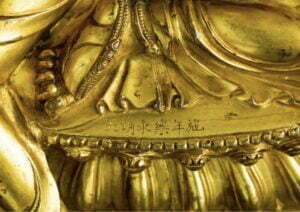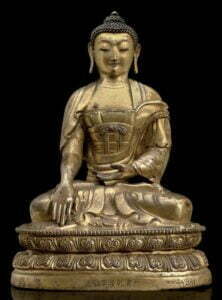Buddhist Gilt Bronzes
Tibetan Buddhism enjoyed imperial favour in China from the Yuan Dynasty and was to be influential in the development of Chinese Buddhist sculpture. The finest gilt bronzes of the early 15th century were made at the Imperial workshops and a number of these examples bear Yongle and Xuande reign marks, which were incised to the upper front section of the base. (Fig GB1.)
The casting of these bronzes is of the highest quality and the fire/mercury gilding is usually of a rich warm tone. (Fig GB2.) These bronzes were strongly influenced by the Tibetan style and with the close links between the Chinese Court and Tibetan hierarchs, a number of these were given as gifts. The measurements of these bronzes were standardised and the Yongle examples were generally between 18cm and 22cm. The intimate scale, careful modelling of the form and the quality of finished detail give these figures special appeal, which is further highlighted by their rich gilding. (Fig GB2.)
Photograph © Sothebys.
Photograph © Rietberg Musem.
Photograph © Christie’s.
During the Kangxi period (1662-1722), a special commission of bronze figures of Amitayus were made in the Imperial workshops in 1686. (Fig GB3.) It is believed that they were made as a gift for the Emperor’s grandmother’s sixtieth birthday who was a devout Buddhist. These are all of identical size, that is 44cm high. The figure is seated cross legged in dhyanasana with his hands together in the gesture of meditation – dhyanamudra. The figure sits on a double lotus base and each end of the scarf extends over the petals, which is characteristic of bronzes of this period.
During the Qianlong period (1736-1795) in the 18th Century, there was a proliferation of bronze figures, especially of Amitayus, which bear Qianlong reign marks, (Figs GB4.) but these were made for more general consumption and not for the imperial court. Another series of bronzes that were produced at this time, was a group of repoussé figures of Buddha marked in Manchu and Tibetan script reading Weiguang Fo and Da Qing Qianlong nian jingzao (Respectfully made in the Qianlong period of the Great Qing dynasty). (GB5.) The repoussé technique was where the form was not cast but worked from sheet metal, often into a mould. The heads and hands were often cast separately and added once the repoussé work was completed.




